You’ve heard all about the diets, the physical activity, and changing your behavior. But, how do you stick with them? Let’s briefly review each then, you’ll learn how to work on these areas and be able to stick it out when the going gets tough.
Diet
Everyday on the news there is talk about this diet and that one; so much talk that you’re weary of it. This diet, that diet, they never end. But, what many of them tell you is to quit eating carbs. You can’t have ice cream, cake, cookies, pasta, there’s no end to it. It doesn’t have to be that way nor, should it – your body needs carbs. Here’s why! There’s an old nutritionist adage that says, “fats burn in a carbohydrate flame.” What this means is that to burn fat adequately, you must have carbohydrates. How many carbs are adequate? At least 100 grams of carbohydrates per day are needed to prevent fatigue and dangerous fluid imbalances. To make sure you get enough carbohydrates, eat 6-11 servings from the Bread, Cereal, Rice, and Pasta Group on the Food Guide Pyramid every day or modify to the Choose My Plate method, which the government has used to update the older food guide pyramid. When you compare the two, there is not a significant difference.
USDA Food Guide Pyramid
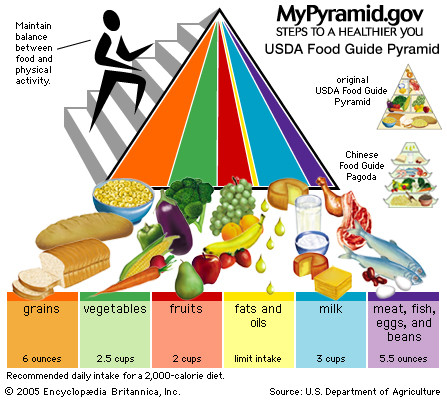
USDA Choose My Plate (Replaces the last Food Guide Pyramid above)
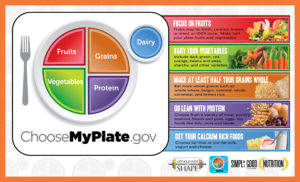
Like everything in life, carbohydrates are good for you when eaten in moderation such as one serving instead of three. In addition to carbs, a daily fiber intake of 20 to 30 grams should be consumed. Adequate fiber helps with proper bowel function. If you were to eat 1 cup of bran cereal, 1/2 cup of carrots, 1/2 cup of kidney beans, a medium-sized pear, and a medium-sized apple together in 1 day, you would get about 30 grams of fiber. That’s quite a bit of food so, you can readily appreciate that you do not need to starve yourself. Factually, by eating a balanced meal plan you’ll get all the calories, energy, and fiber you need. But most importantly, you can enjoy what you eat.
What about fats? No more than 30 percent of calories, on average, should be consumed from fat per day, with less than 10 percent of calories from saturated fat (examples are fat from meat, butter, and eggs). Limiting fat to these levels reduces your risk for heart disease and may help you lose weight. Additionally, you should limit the amount of cholesterol in your diet. Cholesterol is a fat-like substance found in animal products such as meat and eggs. Your diet should include no more than 300 milligrams of cholesterol per day (one egg contains about 215 milligrams of cholesterol, and 3.5 ounces of cooked hamburger contain 100 milligrams of cholesterol). For eggs consider egg substitutes and egg whites to limit cholesterol from this source. If you’re a real meat lover, consider eating grilled chicken and fish rather than beef. This will greatly lower saturated fat intake. Also, use skim milk rather than whole milk. There are also other milk products on the market that are very healthy and taste good. Small changes can make big differences. If you’d like to know the best foods to eat, check out our good foods area in the nutrition section.
Advertisement: Silk (click on photo for more info)
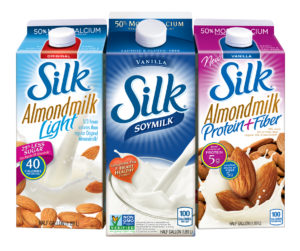
In addition to basic carbohydrates and fats, you also need protein. A good rule of thumb is about 1/2 to one gram per pound of body weight per day. Also, you need fluids to keep the body functioning properly. At least 8 to 10 glasses, 8 ounces each, of water or water-based beverages, per day. You’ll need more water if you exercise a lot. Choose nutrients that come from a variety of low-calorie, nutrient-rich foods.
Types of diets
Fixed-menu diet. A fixed-menu diet provides a list of all the foods you will eat. This kind of diet can be easy to follow because the foods are selected for you. But, you get very few different food choices, which may make the diet boring and hard to follow away from home. This is normally the type diet you would get from most companies because they’re easy to design. It’s like a one-size-fits-all situation. In addition, fixed-menu diets do not teach the food selection skills necessary for keeping weight off. If you start with a fixed-menu diet, you should switch eventually (4-10 weeks) to a plan that helps you learn to make meal choices on your own, such as an exchange-type diet.
Exchange-type diet. An exchange-type diet is a meal plan with a set number of servings from each of several food groups. Within each group, foods are about equal in calories and can be interchanged as you wish. For example, the “starch” category could include one slice of bread or 1/2 cup of oatmeal; each is about equal in nutritional value and calories. If your meal plan calls for two starch choices at breakfast, you could choose to eat two slices of bread, or one slice of bread and 1/2 cup of oatmeal. With the exchange-type diet plans, you have more day-to-day variety and you can easily follow the diet away from home. The most important advantage is that exchange-type diet plans teach the food selection skills you need to keep your weight off. This kind of plan will help you more quickly become your own nutrition expert.
Advertisement: Amazon (click on photo for more info)
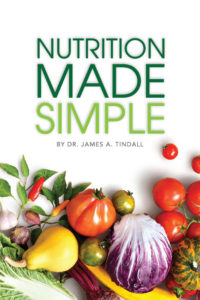
Prepackaged-meal diet. These diets require you to buy prepackaged meals. Such meals may help you learn appropriate portion sizes. However, they can be costly. Before beginning this type of program, find out whether you will need to buy the meals and how much the meals cost. You should also find out whether the program will teach you how to select and prepare food – skills that are needed to sustain weight loss.
Formula diet. Formula diets are weight-loss plans that replace one or more meals with a liquid formula. Most formula diets are balanced diets containing a mix of protein, carbohydrate, and usually a small amount of fat. Formula diets are usually sold as liquid or a powder to be mixed with liquid. Although formula diets are easy to use and do promote short-term weight loss, most people regain the weight as soon as they stop using the formula because of the craving created for other foods. In addition, formula diets do not teach you how to make healthy food choices, a necessary skill for keeping your weight off.
Questionable diets. You should avoid any diet that suggests you eat a certain nutrient, food, or combination of foods to promote easy weight loss. Or, diets that prescribe completely cutting certain macro nutrients such as carbohydrates or protein. Some of these diets may work in the short term because they are low in calories. However, they are often not well balanced and may cause nutrient deficiencies. In addition, they do not teach eating habits that are important for long-term weight management.
Flexible diets. Some programs or books suggest monitoring fat only, calories only, or a combination of the two, with the individual making the choice of both the type and amount of food eaten. This flexible type of approach works well for many people, and teaches them how to control what they eat. One drawback of flexible diets is that some don’t consider the total diet. For example, programs that monitor fat only often allow people to take in unlimited amounts of excess calories from sugars, and therefore don’t lead to weight loss.
It is important to choose an eating plan that you can live with. The plan should also teach you how to select and prepare healthy foods, as well as how to maintain your new weight. Remember that many people tend to regain lost weight. Eating a healthful and nutritious diet to maintain your new weight, combined with regular physical activity, helps to prevent weight regain.
Physical activity
Regular physical activity is important to help you lose weight and build an overall healthy lifestyle. Physical activity increases the number of calories your body uses and promotes the loss of body fat instead of muscle and other nonfat tissue. Research shows that people who include physical activity in their weight-loss programs are more likely to keep their weight off than people who only change their diet. In addition to promoting weight control, physical activity improves your strength and flexibility, lowers your risk of heart disease, helps control blood pressure and diabetes, can promote a sense of well-being, and can decrease stress.
Any type of physical activity you choose to do, vigorous activities such as running or aerobic dancing or, moderate-intensity activities, such as walking or household work, will increase the number of calories your body uses. The key to successful weight control and improved overall health is making physical activity a part of your daily life.
For the greatest overall health benefits, experts recommend that you perform 20 to 30 minutes of vigorous physical activity (see the following Activities Chart) three or more times a week and some type of muscle strengthening activity, such as weight resistance, and stretching at least twice a week. However, if you are unable to do this level of activity, you can improve your health by performing 30 minutes or more of moderate-intensity physical activity (see the Activities Chart) over the course of a day, at least five times a week. However, twice this amount of time will give you very good results in a much shorter time.
When including physical activity in your weight-loss program, you should choose a variety of activities that can be done regularly and are enjoyable for you. Also, if you have not been physically active, you should see your doctor before you start, especially if you are older than 40 years of age, very overweight, or have medical problems. For a comparison of calories burned by activity, see “Facts about Burning Fat.”
Physical Activities Chart
Vigorous activities
Aerobic dancing
Brisk walking
Cycling
Running
Spinning class (cycles)
Sprinting
Swimming
Moderate-intensity common daily activities
Playing actively with children
Using a push mower to cut the grass
Walking up the stairs instead of taking the elevator
Walking part or all the way to work
Walking after work just to get started
Now that we’ve refreshed the basics for you on diet and exercise, you must decide to eat healthy and exercise regularly on your own. This is the most difficult part. To do this requires that you to modify your behavior. Sounds easy enough.
Behavior change
Behavior change focuses on learning eating and physical activity habits that will help you lose weight and keep it off. The first step is to look at your eating and physical activity habits thus, uncovering behaviors (such as watching television 40 hours or more per week) that lead you to overeat or be inactive. Next, you’ll need to learn how to change those behaviors. Getting support from others is a good way to help you maintain your new eating and physical activity habits. Changing your eating and physical activity behaviors increases your chances of losing weight and keeping it off. For additional information on behavior change, you may wish to ask a weight-loss counselor or refer to books on this topic, which are available in local libraries.
Advertisement: Amazon (click on photo for more info)
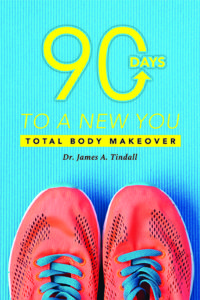
The single most important choice for this process is to determine what works for you? However, one simple fact stands above all others. If you do not enjoy it, you will not stick with it for long. This means that you must choose a diet type with foods that you like and that you must choose exercises that you enjoy and can perform easily, at least in the early stages. Remember this key and you’ll do well.
So, let’s create a habit. How? By performing the task each day for at least three weeks. For example, you have not exercised for a long time and cannot seem to get into it because you just do not like it, try this: while you’re watching your favorite television show, choose two commercial breaks and exercise throughout each of these two commercials. You can try sit ups, in-place squats, dumbbell weights, a stationary bike, pushups, stretching, jumping jacks, almost anything that will increase your heart rate. Then, do this for three weeks straight. Don’t be surprised when it becomes a habit. Work yourself into your diet and exercise plan slowly, increasing about 5-10 percent in activity each week. As an example, if for the first week you do 10 minutes of exercise each day, for the second week do 11-12 minutes per day. Before you know it, you’ll be exercising every commercial break and you know what, once you’re there you’ll absolutely love it. What are you waiting for?
A variety of options exist to help you lose weight and keep it off. The key to successful weight loss is making changes in your eating and physical activity habits that you will be able to maintain. This website will help provide information for you to succeed!







